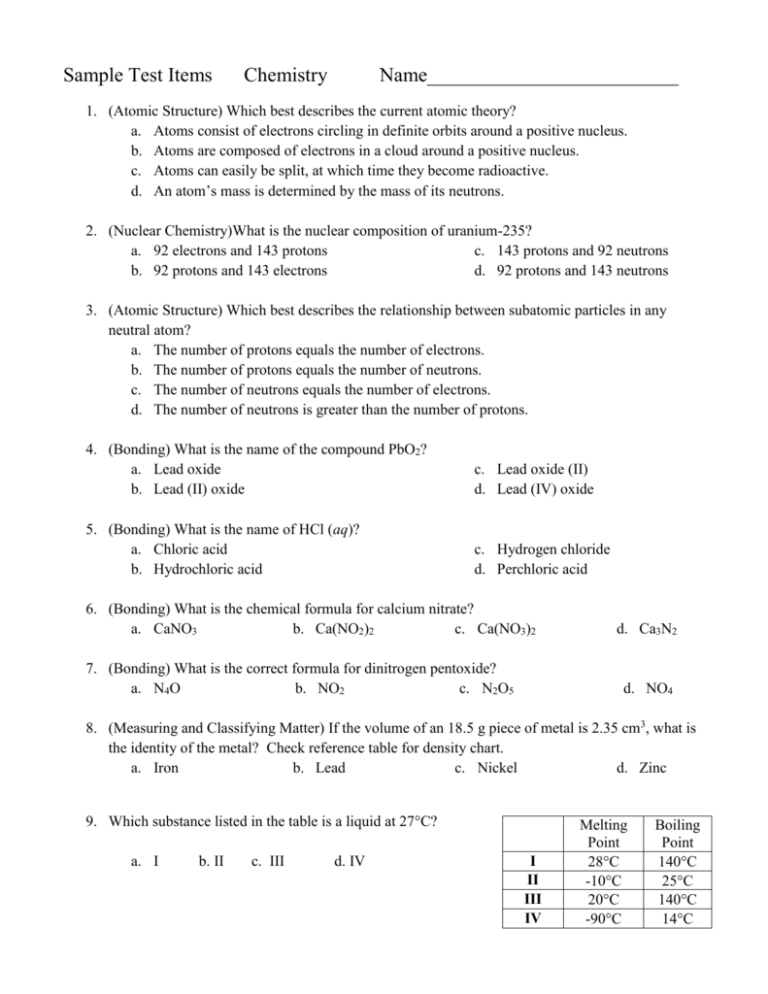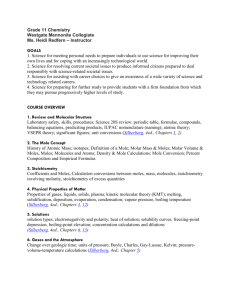Chemistry Sample Test Items
advertisement

Sample Test Items Chemistry Name_________________________ 1. (Atomic Structure) Which best describes the current atomic theory? a. Atoms consist of electrons circling in definite orbits around a positive nucleus. b. Atoms are composed of electrons in a cloud around a positive nucleus. c. Atoms can easily be split, at which time they become radioactive. d. An atom’s mass is determined by the mass of its neutrons. 2. (Nuclear Chemistry)What is the nuclear composition of uranium-235? a. 92 electrons and 143 protons c. 143 protons and 92 neutrons b. 92 protons and 143 electrons d. 92 protons and 143 neutrons 3. (Atomic Structure) Which best describes the relationship between subatomic particles in any neutral atom? a. The number of protons equals the number of electrons. b. The number of protons equals the number of neutrons. c. The number of neutrons equals the number of electrons. d. The number of neutrons is greater than the number of protons. 4. (Bonding) What is the name of the compound PbO2? a. Lead oxide b. Lead (II) oxide c. Lead oxide (II) d. Lead (IV) oxide 5. (Bonding) What is the name of HCl (aq)? a. Chloric acid b. Hydrochloric acid c. Hydrogen chloride d. Perchloric acid 6. (Bonding) What is the chemical formula for calcium nitrate? a. CaNO3 b. Ca(NO2)2 c. Ca(NO3)2 7. (Bonding) What is the correct formula for dinitrogen pentoxide? a. N4O b. NO2 c. N2O5 d. Ca3N2 d. NO4 8. (Measuring and Classifying Matter) If the volume of an 18.5 g piece of metal is 2.35 cm3, what is the identity of the metal? Check reference table for density chart. a. Iron b. Lead c. Nickel d. Zinc 9. Which substance listed in the table is a liquid at 27C? a. I b. II c. III d. IV I II III IV Melting Point 28C -10C 20C -90C Boiling Point 140C 25C 140C 14C 10. (Acids and Bases) Which will increase the solubility of most solid solutes? a. Decreasing the temperature b. Decreasing the amount of solvent at constant temperature c. Increasing the amount of solute at constant temperature d. Increasing the temperature 11. (Bonding) The compound formed between element X and oxygen has the chemical formula X2O. Which element would X most likely represent? a. Fe b. Zn c. Ag d. Sn 12. (Bonding) Which electron configuration represents a transition element? a. 1s22s22p3 c. 1s22s22p63s23p64s23d7 b. 1s22s22p63s2 d. 1s22s22p63s23p64s23d104p4 13. (Bonding) Given the electron configuration of 1s22s22p4, how many electrons does this element have in its outer level? a. 2 b. 4 c. 6 d. 8 14. (Periodic Table & Trends) Which correctly lists four atoms from smallest to largest radii? a. I, Br, Cl, F b. F, I, Br, Cl c. Si, P, S, Cl d. Cl, S, P, Si 15. (Periodic Table & Trends) Which have the lowest electronegativities? a. Alkali metals c. Rare earth elements b. Halogens d. Transition metals 16. (The Mole & Stoichiometry) How many moles are in 59.6 grams of BaSO4? a. 0.256 mole c. 13.9moles b. 3.91 moles d. 59.6 moles 17. (The Mole & Stoichiometry) What is the volume of two moles of hydrogen gas at STP? a. 44.8 L b. 22.4 L c. 11.2 L d. 2.00 L 18. (The Mole & Stoichiometry) How many molecules are contained in 55.0 g of H2SO4? a. 0.561 molecule c. 3.38 x 1023 molecules b. 3.93 molecules d. 2.37 x 1024 molecules 19. (The Mole & Stoichiometry) If a sample of magnesium has a mass of 60 g, how many moles of magnesium does the sample contain? a. 1.1 moles b. 1.2 moles c. 2.0 moles d. 2.5 moles 20. (Solutions) How many grams of KCl are necessary to prepare 1.5 L of a 0.500 M solution of KCl? a. 224 g b. 74.6 g c. 56.0 g d. 24.9 g 21. (Solutions) What is the molarity of a solution containing 20.0 g of sodium hydroxide dissolved in 1.0 L of solution? a. 0.5 M b. 0.4 M c. 0.3M d. 0.2 M 22. (Molar Mass, Percent Composition, Empirical and Molecular Formulas) Analysis shows a compound to be, by mass, 43.8% N, 6.2% H and 50.0% O. Which is a possible molecular formula for the substance? a. NH4NO2 b. NH4NO3 c. NH3OH d. N2OH 23. (Molar Mass, Percent Composition, Empirical and Molecular Formulas) A compound has an empirical formula of CH2O and a molecular mass of 180 g. What is the compound’s molecular formula? a. C3H6O3 b. C6H12O6 c. C6H11O7 d. C12H22O11 24. (Molar Mass, Percent Composition, Empirical and Molecular Formulas) What is the percent by mass of iron in the compound Fe2O3? a. 70% b. 56% c. 48% d. 30% 25. (The Mole & Stoichiometry) Metallic sodium reacts violently with water to form hydrogen and sodium hydroxide according to the balanced equation: 2Na + 2H2O 2NaOH + H2 How many moles of hydrogen gas are generated when 4.0 moles of sodium react with excess water? a. 1.0 mole b. 2.0 moles c. 3.0 moles d. 4.0 moles 26. (The Mole & Stoichiometry) Consider this reaction: 3Ca (s) + 2H3PO4 (aq) Ca3(PO4)2 (s) + 3H2 (g) How many moles of calcium are required to produce 60 g of calcium phosphate? a. 0.145 mole b. 0.194 mole c. 0.387 mole d. 0.581 mole 27. (The Mole & Stoichiometry) According to the equation 2H2O (l) 2H2 (g) + O2 (g), what mass of water is required to yield 22.4 L of oxygen gas at STP? a. 12 g b. 18 g c. 24 g d. 36 g 28. (The Mole & Stoichiometry) Consider this reaction: 3Mg (s) + 2H3PO4 (aq) Mg3(PO4)2 (s) + 3H2 (g) How many grams of magnesium phosphate should be produced if 5.40 g of magnesium react? a. 1.8 g b. 19. 5 g c. 58.4 g d. 175 g 29. (The Mole & Stoichiometry) Methane (CH4) is burned in oxygen according to this balanced chemical equation: CH4 (g) + 2O2 (g) CO2 (g) + 2H2O (g) What volume of carbon dioxide is formed when 9.36 L of methane are burned at STP? a. 9.36 L b. 15.0 L c. 18.7 L d. 22.4 L 30. (Nuclear Chemistry) Consider this diagram: Which of the three types of radiation will penetrate the paper and wood? a. Alpha, beta and gamma b. Alpha and beta only c. Gamma only d. Beta only 31. (Nuclear Chemistry) The half-life of phosphorus-32 is 14.30 days. How many milligrams of a 20 mg sample will remain after 85.8 days? a. 3.333 mg b. 0.6250 mg c. 0.3125 mg d. 0.1563 mg 32. (Nuclear Chemistry) In the figure below, what type of nuclear activity is represented? a. Fission b. Fusion c. Alpha emission d. Beta emission 59 33. (Nuclear Chemistry) Which particle will complete this reaction? 27𝐶𝑜 + ? → a. Electron c. Nucleus b. Neutron d. Proton 60 27𝐶𝑜 34. (Nuclear Chemistry) Which will complete this equation? b. 00𝛾 c. a. −10𝑒 238 92𝑈 1 1𝐻 → 234 90𝑇ℎ + ? d. 4 2𝐻𝑒 35. (Chemical Reactions) Consider this reaction: NH3 (g) + HCl (g) NH4Cl (s) Which type of reaction does this equation represent? a. Combustion b. Decomposition c. Single replacement d. Synthesis 36. (Chemical Reactions) Which equation represents a single replacement reaction that can occur? a. F2 + 2NaCl 2NaF + Cl2 c. Cu + 2NaCl CuCl2 + 2Na b. Cl2 + 2NaF 2NaCl + F2 d. Zn + 2NaF ZnF2 + 2Na 37. (Chemical Reactions) What products are formed when the metal potassium is added to water? a. K and H2O c. K2O and H2 b. KOH and H2O d. KOH and H2 38. (Chemical Reactions) When Na2O reacts with water, what is produced? a. HNaO2 b. Na + H2O c. NaO + H2 39. (Chemical Reactions) What coefficients are required to balance this equation? __Fe + __CO2 a. 2, 6, 3,6 c. 1, 1, 2, 2 b. 1, 3, 2, 3 d. 1, 1, 2, 1 d. NaOH __Fe2O3 + __CO 40. (Chemical Reactions) Which example indicates that a chemical change has occurred? a. When two aqueous solutions are mixed, a precipitate is formed. b. As ammonium nitrate dissolves in water, it causes the temperature of the water to decrease. c. Alcohol evaporates when left in an open container. d. Water is added to blue copper (II) chloride solution. The resulting mixture is lighter blue in color. 41. (Acids and Bases) Consider this chemical equations: NH3 (aq) + HCl (aq) NH4+1 (aq) + Cl-1 In this reaction, why is the ammonia considered a base, according to Arrhenius? a. b. c. d. NH3 donates an electron(s). NH3 decreases the hydroxide ion concentration. NH3 accepts a proton (hydrogen). NH3 donates a proton (hydrogen). 42. (Acids and Bases) Phenolphthalein is an indicator that turns pink when added to a basic solution. In which solution would phenolphthalein turn pink? a. NaOH b. HCl c. H2O d. NaCl 43. (Acids and Bases) A water sample was found to have a pH of 6 at 25C. What is the hydroxide concentration in the water sample? a. 1 x 10-8 M c. 1 x 10-6 M b. 6 x 10-8 M d. 6 x 10-6 M 44. (Acids and Bases) What is the pH of a solution of KOH with a hydroxide concentration of [OH-1] = 1 x 10-4 M? a. -10 b. -4 c. 4 d. 10 45. (Acids and Bases) In a titration experiment, if 30 mL of an HCl solution reacts with 24.6 mL of a 0.5 M NaOH solution, what is the concentration of the HCl solution? a. 0.41 M b. 0.61 M c. 1.5 M d. 370 M 46. (Chemical Reactions) Consider this balanced chemical equation: 2H2O2 (aq) 2H2O (l) + O2 Which of the following will increase the rate of the reaction? a. Increasing pressure on the reaction b. Decreasing concentration of the reactants c. Adding a catalyst to the reaction d. Decreasing the temperature of the reaction 47. (Bonding) Which molecule is nonpolar? a. H2O b. HF c. NF3 d. CF4 48. (Bonding) The arrangement of atoms in a water molecule, H2O, is best described as a. ring b. bent c. linear d. spherical 49. (Bonding) In which pair do both compounds exhibit ionic bonding? a. SO2, HCl c. NaF, KBr d. KCl, CO2 b. KNO3, C2H4 50. (Bonding) Covalent bonds are most likely to be found in the compound represented by the formula: a. NaCl b. KBr c. CH4 d. CaF2







